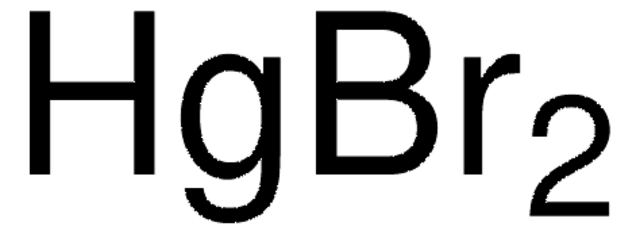83353
Mercury(II) bromide
puriss. p.a., ACS reagent, ≥99.0% (precipitation titration)
Synonym(s):
Mercuric bromide
About This Item
Recommended Products
grade
ACS reagent
puriss. p.a.
vapor pressure
1 mmHg ( 136.5 °C)
Assay
≥99.0% (precipitation titration)
form
powder or crystals
ign. residue (after reduction)
≤0.02%
bp
322 °C (lit.)
mp
236 °C (lit.)
anion traces
chloride (Cl-): ≤2000 mg/kg
sulfate (SO42-): ≤50 mg/kg
cation traces
Ca: ≤10 mg/kg
Cd: ≤5 mg/kg
Co: ≤5 mg/kg
Cr: ≤5 mg/kg
Cu: ≤5 mg/kg
Fe: ≤5 mg/kg
K: ≤50 mg/kg
Mg: ≤5 mg/kg
Mn: ≤5 mg/kg
Na: ≤50 mg/kg
Ni: ≤5 mg/kg
Pb: ≤5 mg/kg
Zn: ≤5 mg/kg
SMILES string
Br[Hg]Br
InChI
1S/2BrH.Hg/h2*1H;/q;;+2/p-2
InChI key
NGYIMTKLQULBOO-UHFFFAOYSA-L
Looking for similar products? Visit Product Comparison Guide
General description
Signal Word
Danger
Hazard Statements
Precautionary Statements
Hazard Classifications
Acute Tox. 1 Dermal - Acute Tox. 1 Inhalation - Acute Tox. 2 Oral - Aquatic Acute 1 - Aquatic Chronic 1 - STOT RE 2
Storage Class Code
6.1B - Non-combustible acute toxic Cat. 1 and 2 / very toxic hazardous materials
WGK
WGK 3
Flash Point(F)
Not applicable
Flash Point(C)
Not applicable
Certificates of Analysis (COA)
Search for Certificates of Analysis (COA) by entering the products Lot/Batch Number. Lot and Batch Numbers can be found on a product’s label following the words ‘Lot’ or ‘Batch’.
Already Own This Product?
Find documentation for the products that you have recently purchased in the Document Library.
Our team of scientists has experience in all areas of research including Life Science, Material Science, Chemical Synthesis, Chromatography, Analytical and many others.
Contact Technical Service











